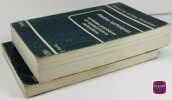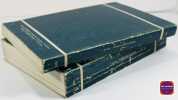-
Type
Book (3368)
Magazine (9)
-
Latest
Last 24h (1)
Last month (15)
Last week (1)
-
Century
16th (18)
17th (48)
18th (208)
19th (895)
20th (1354)
21st (130)
-
Countries
Belgium (427)
Denmark (656)
France (1120)
Italy (957)
Switzerland (217)
-
Syndicate
ILAB (2314)
NVVA (20)
SLACES (20)
SLAM (554)
Motivbog for Kleinsmede. Udgivet af Fællesrepræsentationen for Dansk Industri og Haandværk. Kbhvn., 1926.
Folio. Orig. papirsmappe med rifter. Indeholder 51 (af 52) folioblade med mønstertegninger.
LES PLAISIRS DE LA TABLE.
Où, sous une forme nouvelle, l'Auteur a dévoilé maints délicieux secrets et recettes de bonne cuisine, transcrit les précieux avis de gourmets fameux et de fins gastronomes, conseillers aimables et surs en l'Art du Bien-Manger. chez Meynial, Paris, s.d. (1926). In-8 p. (mm. 227x185), tela mod., fregi e tit. oro su tassello al dorso, conserv. copertina orig., pp.num. 333, illustrato nel t. dai deliziosi disegni in tinta di P.F. Grignon (frontesp., stemmi dei mestieri rappresentati all'inizio di ogni capitolo, capilettera, testat. e finalini). Prefazione di Robert de Flers. L'opera è suddivisa in 12 capitoli: "Hors d'oeuvres. Potages. Sauces et garnitures. Oeufs. Poissons. Entrées chaudes. Le froid. Rotis. Légumes. Farines et pates d'Italie. Salades. Friandises"."Prima edizione" di questo famoso libro di cucina, scritto da uno dei più grandi cuochi dellla prima metà del XX secolo, al servizio dapprima dello Zar Nicola II e poi dell'Imperatore d'Austria, divenuto in seguito proprietario del celebre ristorante parigino Larue.Cfr. Bitting, p. 343. Manca al Vicaire.Bella edizione "sur vergé antique", con dedica autografa dell'A. a Nicolas de Sangro. Ben conservato.
Vorschlag, um Wassergräben bei Festungen gehörig vom Eise frei zu halten, und Bericht über den deshalb Versuch bei Kopenhagen, im Winter 1828 und 1829. Mit einer lithographirten Tafel.
Kopenhagen, Gyldendal, 1833. Contemp. hcalf. gilt spine. A paperlabel pasted on spine. Stamp on titlepage. 51 pp., 1 large folded lithographed plate. Scattered brownspots.
LA CONQUISTA DELLA FORZA.
L'elettricità a buon mercato. La nazionalizzazione delle forze idrauliche. Roux e Viarengo, Torino-Roma, 1905. In-8 p., bross. (dorso muto, piatti con lievi macchie), pp. 362. Con lettere e studi di G. Colombo, senatore: V. de Asarta, deputato e dei professori Capitò, Chistoni, Lombardi, Masoni, Pagliani, ecc.. Edizione originale. Testo ben conservato.
Zilveren-Jubileumboek ; Voordrachten gehouden tijdens en studies ingezonden t.g.v. het Internationaal Technisch-Economisch Congres, gehouden te Antwerpen van 14 tot 19 juni 1954 bij de viering van het vijfde lustrum van de koninklijke Vlaamse Ingenieursvereniging 1928-1953
, Antwerpen, Koninklijke Vlaamse Ingenieursvereniging 1954, 644pp.geïll. + li pp. publiciteit, linnen band, Bijzonder nummer van het "Technisch Wetenschappelijk Tijdschrift", 24°Jg., maart 1954
On the Pressure required to give Rotation to rifled Projectiles.
(London), 1873. Contemp. clothbacked. boards. Titlelabel with gilt læettering to frontboard. Stamps to titlepage. Extracted from ""The hilosophical Magazine for March 1873"" pp. (1-) 12 and 1 folded plate.
LA FAUCILLE. RAPPORT DE M. NOBLEMAIRE.
Tirage spécial pour l'Association pour le Percement de la Faucille. Imprimerie Wyss et Duchène, Genève, 1901. In-8, brossura editoriale, pp. 15. Estratto del Bulletin n° 16 du 31 Janvier 1901 della Chambre de Commerce française de Genève. Contiene: De Paris a Milan par Genève - Tableau comparatif des distances entre Paris-Genève, Paris-Milan et Calais-Milan. Ben conservato.
Design - Le Geste et le Compas
Editions France-Loisirs, 1988. Grand in-8. Cartonnage sous jaquette illustrée en couleurs. Riche iconographie in et hors texte en noir et en couleurs. 384 pages. Contient des biographies de designers et une bibliographie sélective. Très bon état.
MANUEL DU FILATEUR.
Ou art de la filature de coton, enseigné en quatorze leçons, et mis à la portée des ouvrier. Audin et Urbain Canel, Paris, 1825. In-16 gr., cartonato muto mod., conserv. cop. orig., pp. (4),376, ben illustr. da 13 tavv. f.t., più volte ripieg.e inc. in rame. Con lievi fioriture o arrossature, prime 10 cc. con angolo superiore mancante, ma certamente un buon esemplare intonso.
DIZIONARIO DELLE INVENZIONI, ORIGINI E SCOPERTE RELATIVE AD ARTI, SCIENZE, GEOGRAFIA, STORIA, AGRICOLTURA, COMMERCIO, EC.
Che indica le epoche dello stabilimento dei popoli, delle religioni, sette, leggi e dignità; lorigine delle costumanze, delle mode, degli usi, delle monete, ec.; ugualmente che le date delle invenzioni utili e scoperte importanti fatte sino al presente. Traduzione dal francese di Angiolo Orvieto. Antonelli e C., Livorno, 1850. In-8 gr. (mm. 253x165), mz. pelle coeva, fregi e titolo oro su tassello al dorso, pp. 528. Fioriture intercalate nel testo, ma complessivamente buon esemplare.
ELECTROTHERAPIE.
Physiothérapie. Bailliere, Paris, 1909. In-16 gr., tela editoriale, pp. XVI,528,(8), con 251 figg. nel t. Electrotechnique - Electrophysiologie - Electrodiagnostic - Electrothérapie clinique. Ben conservato.
Essai sur l'Electricité des Corps.
Paris, Durand, 1771. 100 X 170 mm. relié plein veau marbré, dos à nerfs orné à chaud, tranches rouges (rel. de l'ép.). Frontispice gravé, XXIV- 276 pp. Avec 4 planches gravées dépliantes. Reliure frottée avec les coiffes usées, les coins émoussés et quelques épidermures, étiquette de bibliothèque sur garde.
Phone number : 41 021 964 60 10
Recueil de normes françaises - Dessins techniques (2 tomes)
Afnor 1983 Broché - Tome 1 : Principes généraux principes de représentation cotation et tolérancement - 318 pages / tomes 2 : Symboles graphiques et représentations particulières - 675 pages Etat correct - Couverture cornées et frottées 1 116 g
Je sais faire mes conserves, Image par image. N° 1 : fruits d'été
Sedes. 1980. In-4. Broché. Bon état, Couv. convenable, Dos satisfaisant, Intérieur bon état. 64 pages illustrées de nombreuses photos en couleurs. Encyclopédie mensuelle.. . . . Classification Dewey : 664-Technologie des aliments
Classification Dewey : 664-Technologie des aliments
Technologie de construction mécanique - TOME 2
Peladan et le Cannellier 1969 in4. 1969. Cartonné. schémas en noir et blanc
tome 2 seul - Bon état d'ensemble cependant couverture défraîchie bords frottés intérieur propre
Tarif de cubage des bois en grume et équarris donnant le cube au réel au 1/4 de la circonférence sans déduction et au 1/5 déduit - 43e édition 1962.
R.M.Normand. 1962. In-16. Relié. Etat d'usage, Couv. convenable, Dos satisfaisant, Papier jauni. 132 pages.. . . . Classification Dewey : 674-Technologie du bois et du liège
Les circonférences de 0m02 en 0m02 les longueurs de 010 et 0m10. Classification Dewey : 674-Technologie du bois et du liège
NOUVEAU MANUEL DU MENUISIER, DE L'EBENISTE ET DU LAYETIER (avec) NOUVEU MANUEL DU TOURNEUR, OU TRAITE' COMPLET ET SIMPLIFIE' DE CET ART.
Manuels-Roret. Nouvelle édition très augmentée. Ouvrage orné de planches. Librairie Encyclopédique de Roret, Paris, 1839. In-24 gr. (mm. 140x85), 5 volumi (di cui 1 di tavole per entrambe le opere), mz. pelle coeva, dorso a cordoni con fregi e tit. oro. La raccolta, completa, è così composta:- Nouveau manuel du menuisier, de l'ébéniste.., 2 volumi, pp. 302; 328; con 14 tavole, inc. in rame e più volte ripieg., che contengono 439 figure.- Nouveau manuel du tourneur, 2 volumi, pp. (4),IV,306; (4),314; con 7 tavole, inc. in rame e più volte ripieg., ciascuna con numerosiss. figure.Con qualche fiorit. o uniformi arross., ma buoni esemplari.
Manuel du menuisier en meubles et en bâtimens, suivi de l'art de l'ébéniste - Tome 1er
Roret. 1827. In-18. Broché. Etat d'usage, Couv. légèrement passée, Dos plié, Quelques rousseurs. 373 pages. Quelques traces de mouillures.. . . . Classification Dewey : 674-Technologie du bois et du liège
Classification Dewey : 674-Technologie du bois et du liège
NUOVO CODICE DELL'INGEGNERE.
Civile - Industriale - Ferroviario - Navale - Elettrotecnico. Hoepli, Milano, 1906. In-24 gr., p. pelle editoriale, pp. XXVII,1341, testo su due colonne. Raccolta di leggi, regolamenti e circolari con annotazioni. Prima edizione. Ben conservato. .
Battle Tactics of Napoleon and His Enemies: Brent Nosworthy
Constable 2001 547 pages 15 6x3 2x23 2cm. 2001. Broché. 547 pages.
Très Bon Etat de conservation intérieur propre bonne tenue
Travaux Publics en Belgique. 1830-1839. Chemins de Fer et Routes ordinaires. Rapport présenté aux Chambres Législatives le 12 Novembre 1839.
Bruxelles, H. Remy, 1840. Contemp. clothbacked marbled boards. A paperlabel pasted on upper part of spine. Stamps on title-page. II,140 pp., 37 large folded tables.
MAESTR'UGOLINO DA MONTECATINI.
Medico del secolo XIV ed il suo Trattato de' Bagni Termali d'Italia. Hoepli, Milano, 1896. In-4 p., brossura editoriale (lievi strappi e picc. manc.), da p. 144 a 166. Fascicolo III, del volume XX - XI della serie III delle Memorie del R. Istituto Lombardo di Scienze e Lettere - Classe di lettere, scienze storiche e morali.Pagine ingiallite per la qualità della carta, peraltro testo in buono stato.
Kjøbenhavns Tømmerlav. Industrihistoriske Meddelelser.
Københ., 1887. Lex8vo. Samt. hldrbd. (8),358 pp.
Das schmiedbare Eisen. Konstitution und Eigenschaften.
Berlin, Julius Springer, 1920. Orig. half cloth. X, 344 pp. With 345 textillustr. and 1 plate. With library stamps.
 Write to the booksellers
Write to the booksellers











